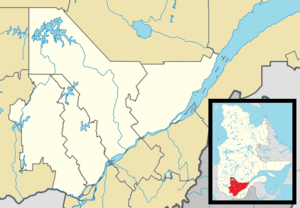Fort Ville-Marie facts for kids
Quick facts for kids Fort Ville-Marie |
|
|---|---|
| Part of Pointe-à-Callière Museum | |

Fort Ville-Marie in 1645
|
|
| Coordinates | 45°30′12″N 73°33′14″W / 45.503407°N 73.553974°W |
| Site information | |
| Owner | Pointe-à-Callière Museum |
| Controlled by | Société de Notre-Dame de Montréal, New France |
| Site history | |
| Built | 1642 |
| Built by | Société de Notre-Dame de Montréal |
| In use | 1611, 1642–1674 |
| Materials | Wood |
| Demolished | 1688 |
| Garrison information | |
| Past commanders |
Paul Chomedey de Maisonneuve |
Fort Ville-Marie was an early French settlement and fort. It was built in May 1642 by a group of French settlers. Their leader was Paul de Chomedey de Maisonneuve. The fort was located on the Island of Montreal in the Saint Lawrence River. This area is now part of Quebec, Canada. The name "Ville-Marie" means "City of Mary" in French. It was named after the Blessed Virgin Mary.
This fort was the very beginning of the city of Montreal. It quickly became an important place for the North American fur trade. It also helped France expand its control in North America. This continued until 1763, when the Treaty of Paris ended the French and Indian War. After this war, France gave the territory of New France to Britain. Because of its historical importance, the site of Fort Ville-Marie was named a National Historic Site of Canada in 1924.
Contents
Early History of the Area
Archaeologists have found many signs of human life in Montreal over the last 1,000 years. In 1535, the explorer Jacques Cartier visited North America for the second time. He saw an Indigenous village called Hochelaga near where Montreal is today. Cartier's notes suggest that the St. Lawrence Iroquoians lived in Hochelaga. They were Indigenous farmers who lived in the St. Lawrence Valley between 1200 and 1600 CE.
When Samuel de Champlain arrived in 1608, he found no trace of the St. Lawrence Iroquoians. They had disappeared about 75 years after Cartier's visit. Historians have different ideas about why they left. Some think they had terrible wars with the Iroquois tribes to the south. Others believe they got sick from diseases brought by Europeans. Or maybe they moved west towards the Great Lakes.
By the time Champlain arrived, the Algonquins and Mohawks used the Saint-Lawrence Valley. They used it for hunting and as a path for war parties. Neither group had permanent homes upriver from Tadoussac.
Champlain's Trading Post
In 1611, Samuel de Champlain built a temporary fort. He set up a fur-trading post where the Pointe-à-Callière stands today. This was part of his plan to create a French colonial empire. He and his team spent a few weeks clearing the land. Champlain named this spot Place Royale. They also dug two gardens and planted seeds. The plants grew well, showing that the soil was good for farming. Champlain returned to Place Royale in 1613.
In 1641, about 50 French settlers, both men and women, sailed to New France. They were recruited by Jérôme Le Royer de la Dauversière. Their goal was to convert the Indigenous people to Christianity. They also wanted to create a perfect Catholic community. This small group was led by Paul de Chomedey de Maisonneuve. They arrived in Quebec with about 40 men and three families. The Godé family, with Nicolas, Francoise, and their four children, is often called the "First Family of Montreal." They spent the winter near Sillery.
Building Ville-Marie
From 1642 to 1676, this area was a meeting place for fur trading. Indigenous people brought their furs to trade with the French. Later, when the Sulpicians planned the settlement, they set aside land for a public market. This market was known as the Place du Marché.
In May 1642, the group left Quebec for the Island of Montreal. The governor of Montmagny wanted them to settle on the Island of Orleans instead. But they arrived on Montreal Island on May 17. Jeanne Mance was also part of this journey.
The new settlers quickly built the Ville-Marie fort. It was built on the same spot where Champlain had stayed years before. The fort could house up to 50 early colonists. Paul Chomedey de Maisonneuve became the first governor of the settlement.
Challenges and Growth
The French and the Dutch (from Fort Orange and New Amsterdam) were mainly interested in trading furs. The Iroquois people had teamed up with the Dutch. The Dutch supplied weapons to the Iroquois. In 1641, a war with the Iroquois began. By 1643, Ville-Marie was already being attacked by Iroquois raids.
By 1649, the situation was very serious. Maisonneuve went back to France to ask for help. In 1653, a group of 100 settler-soldiers came to Ville-Marie to help fight the Iroquois. With them were 15 King's Daughters, young women who came to New France to marry and start families. Jeanne Mance later founded the Hôtel-Dieu de Montréal hospital in Montreal. In its first years, the hospital was located inside the fort.
By 1685, Ville-Marie had about 600 colonists. Most of them lived in simple wooden houses. The church and the seminary of the Sulpician fathers were important buildings. Most trading happened in the Marketplace, near the river. This is where Montrealers and Indigenous people met to trade.
The fort was used from 1642 to 1674. It was torn down in 1688. The entire settlement was then surrounded by walls and defenses during the Indian war. The home of Louis-Hector de Callière was built on this spot in 1695. In 1705, the settlement was officially renamed Montreal.
In 2007, archaeologists found the remains of Ville-Marie under a warehouse in Montreal. In 2015, they found one of the fort's corner posts.
Gallery
-
Pointe-à-Callière archaeological site
Images for kids







